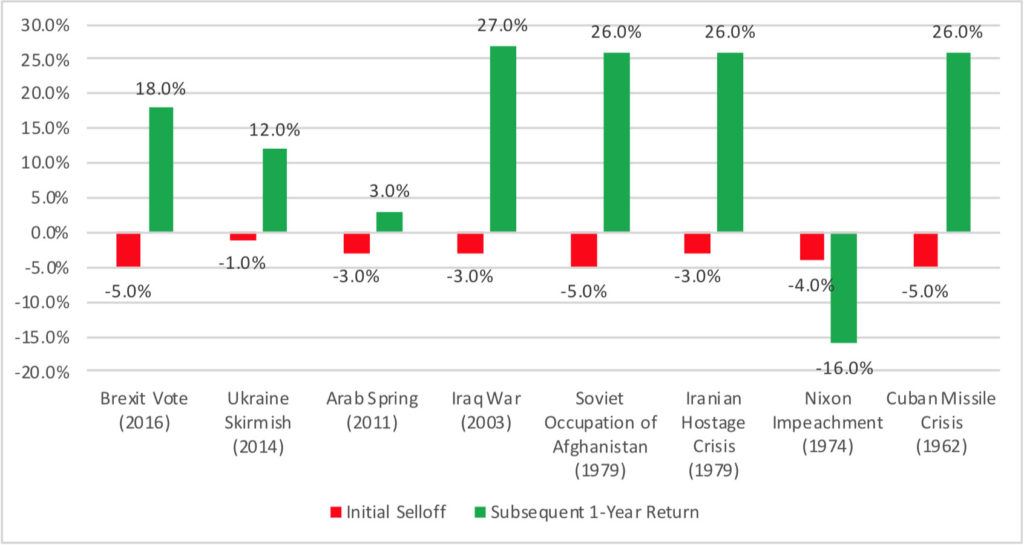
Heat of the Moment
In recent days, Russian President Vladimir Putin has made clear through both words and actions his desire to restore Russian glory via a full-scale invasion of Ukraine. As we write this note, reports of airstrikes in the capital city of Kyiv and many other Ukrainian cities continue to pour in.
At the same time, calls of condemnation and announcements of new punitive sanctions against Russia are pouring in from Europe and the United States at a similarly frenetic pace. For investors, it can be tempting to migrate to the extremes and either 1) completely dismiss the current provocation or 2) assume that we are somehow on the precipice of World War III. The answer is likely somewhere in between.
So what has happened, what could happen, and what does it all mean for your investment portfolio? Here’s what we know with certainty:
- As has been the case historically in times of geopolitical uncertainty, the U.S. dollar remains a preferred safe haven for investors. Yields on 10-year Treasuries fell roughly 20 basis points in just a few trading sessions before rallying sharply off today’s lows.
- Relative to their emerging market peers, U.S. equities appear significantly advantaged in the current environment. This is owing partly to the aforementioned flight to safety, but also to the fact that the U.S. economy remains the most resilient in all of the developed world (not to mention the least energy dependent). Investors certainly agree, as the S&P 500 has outperformed broad emerging market equity indices by over 450 basis points in the last three trading sessions alone.
- The crisis in Ukraine appears to have given cover to the Federal Reserve to slow the anticipated pace of interest rate hikes. As of last Friday, investors were pricing in a roughly 54% chance that the Fed would hike interest rates by a full 50 basis points at its meeting next month, while today that probability has plummeted to just below 19%. This reflects the fact that these military operations are by their very nature debilitating to economic activity, which is exactly what interest rate hikes are intended to accomplish.
- Given Russia’s importance to global oil and gas supply, the recent invasion seems likely to further stoke the fires on inflation. Germany has already suspended the certification process for the vast Nord Stream 2 pipeline, and what is already an energy supply conundrum in Europe could devolve into a real crisis if the current conflict continues beyond the short term.
Lastly, investors will likely find it helpful to study prior periods of intense geopolitical uncertainty and instability to unearth clues about the potential impact to capital markets beyond the immediate term. The chart following examines eight such events in the modern era and illustrates clearly that most geopolitical conflicts typically lack staying power.
Market Performance During and Following Prior Geopolitical Crises

Source: VANGUARD
Of course, there are plenty of things we don’t yet know about the Russia-Ukraine struggle, including the length of the conflict and the associated economic disruptions. On that point, it seems reasonable to assume that Putin has only a small window to make big advances before 1) Russian support deteriorates and 2) the Western response (including both sanctions against Russia and military support for Ukraine) overwhelms Mr. Putin’s ambitions. And even if this current conflict is quickly and positively resolved, risks and uncertainties remain in the geopolitical sphere (China and Taiwan), as well as in the future direction of monetary and fiscal policy in the U.S. and abroad.
The situation in Ukraine has clearly introduced new risks that the market is working to digest. At Highland, we continue to rely on data-driven, probabilistic decision making to drive positive outcomes for clients. Based on our analysis, we remain constructive on both our broad asset allocation positioning and framework, as well as the ability of our trusted managers to navigate volatile and unpredictable environments. Specifically, we continue to strongly favor U.S. equities over emerging markets in this heightened risk environment based on a combination of superior relative momentum, fundamentals, and governance. We also continue to underweight fixed income, as developments in Ukraine are unlikely to meaningfully derail the Fed’s path to policy normalization. Lastly, we continue to favor inflation-sensitive assets that are simultaneously exposed to secular growth stories, including and especially investments in multifamily and industrial private real estate assets.
IMPORTANT DISCLOSURES: This publication has been prepared by the staff of Highland Associates, Inc. for distribution to, among others, Highland Associates, Inc. clients. Highland Associates is registered with the United States Security and Exchange Commission under the Investment Advisors Act of 1940. Highland Associates is a wholly owned subsidiary of Regions Bank, which in turn is a wholly owned subsidiary of Regions Financial Corporation. Research services are provided through Multi-Asset Solutions, a department of the Regions Asset Management business group within Regions Bank. The information and material contained herein is provided solely for general information purposes only. To the extent these materials reference Regions Bank data, such materials are not intended to be reflective or indicative of, and should not be relied upon as, the results of operations, financial conditions or performance of Regions Bank. Unless otherwise specifically stated, any views, opinions, analyses, estimates and strategies, as the case may be (“views”), expressed in this content are those of the respective authors and speakers named in those pieces and may differ from those of Regions Bank and/or other Regions Bank employees and affiliates. Views and estimates constitute our judgment as of the date of these materials, are often based on current market conditions, and are subject to change without notice. Any examples used are generic, hypothetical and for illustration purposes only. Any prices/quotes/statistics included have been obtained from sources believed to be reliable, but Highland Associates, Inc. does not warrant their completeness or accuracy. This information in no way constitutes research and should not be treated as such. The views expressed herein should not be construed as individual investment advice for any particular person or entity and are not intended as recommendations of particular securities, financial instruments, strategies or banking services for a particular person or entity. The names and marks of other companies or their services or products may be the trademarks of their owners and are used only to identify such companies or their services or products and not to indicate endorsement, sponsorship, or ownership by Regions or Highland Associates. Employees of Highland Associates, Inc., may have positions in securities or their derivatives that may be mentioned in this report. Additionally, Highland’s clients and companies affiliated with Highland Associates may hold positions in the mentioned companies in their portfolios or strategies. This material does not constitute an offer or an invitation by or on behalf of Highland Associates to any person or entity to buy or sell any security or financial instrument or engage in any banking service. Nothing in these materials constitutes investment, legal, accounting or tax advice. Non-deposit products including investments, securities, mutual funds, insurance products, crypto assets and annuities: Are Not FDIC-Insured I Are Not a Deposit I May Go Down in Value I Are Not Bank Guaranteed I Are Not Insured by Any Federal Government Agency I Are Not a Condition of Any Banking Activity.
Neither Regions Bank nor Regions Asset Management (collectively, “Regions”) are registered municipal advisors nor provide advice to municipal entities or obligated persons with respect to municipal financial products or the issuance of municipal securities (including regarding the structure, timing, terms and similar matters concerning municipal financial products or municipal securities issuances) or engage in the solicitation of municipal entities or obligated persons for such services. With respect to this presentation and any other information, materials or communications provided by Regions, (a) Regions is not recommending an action to any municipal entity or obligated person, (b) Regions is not acting as an advisor to any municipal entity or obligated person and does not owe a fiduciary duty pursuant to Section 15B of the Securities Exchange Act of 1934 to any municipal entity or obligated person with respect to such presentation, information, materials or communications, (c) Regions is acting for its own interests, and (d) you should discuss this presentation and any such other information, materials or communications with any and all internal and external advisors and experts that you deem appropriate before acting on this presentation or any such other information, materials or communications.
Source: Bloomberg Index Services Limited. BLOOMBERG® is a trademark and service mark of Bloomberg Finance L.P. and its affiliates (collectively “Bloomberg”). BARCLAYS® is a trademark and service mark of Barclays Bank Plc (collectively with its affiliates, “Barclays”), used under license. Bloomberg or Bloomberg’s licensors, including Barclays, own all proprietary rights in the Bloomberg Barclays Indices. Neither Bloomberg nor Barclays approves or endorses this material or guarantees the accuracy or completeness of any information herein, or makes any warranty, express or implied, as to the results to be obtained therefrom and, to the maximum extent allowed by law, neither shall have any liability or responsibility for injury or damages arising in connection therewith.